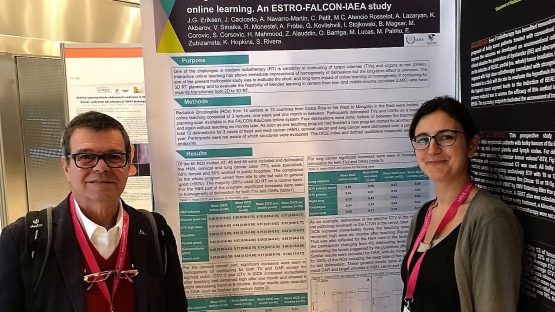The IAEA is launching a new 2-year Coordinated Research Project (CRP) to measure the impact of instructor-led virtual learning on achieving uniformity in radiotherapy contouring practices. The study, which is focused on multidisciplinary staff in low and middle-income countries (LMICs), will seek to determine how the benefits seen from blended learning are maintained when local imaging is used.
Contouring is a key skill used by radiation oncologists when planning for the accurate, precise and consistent delivery of radiation to patients with cancerous tumours. The process uses specially designed computer software to generate 3D images of a patient’s body from medical scans taken using diagnostic imaging tools. These images allow first for the identification of the location and size of cancerous tumours, and second for the outlining of healthy organs. Once these steps have been accomplished, oncologists can better plan, based on tumour size and depth, where radiation should be delivered and how much is needed. This minimizes the exposure to healthy tissues and organs. The more accurately a tumour can be contoured, the more likely the desired treatment goals will be achieved.
The field of radiation oncology has evolved rapidly in recent decades in terms of innovations in treatment equipment, volumetric imaging, information technology and increased knowledge in cancer biology. New delivery technologies and associated imaging modalities have enabled highly optimized precision radiation therapy and supported improvements in tumour control and cancer patient cure.
Concepts and terms for the definition of Gross Tumour Volume, Clinical Target Volume and Organs At Risk (OARs) have continued to advance, in part through a series of International Commission on Radiation Units and Measurements (ICRU) reports, becoming widely disseminated and accepted by the European and international radiation oncology community. The selection and contouring of target volumes – both organs and tumours – and OARs has become a key point in modern radiation oncology. However, despite ICRU reports and guidelines from international organizations such as the European Society for Radiotherapy and Oncology (ESTRO) and the Radiation Therapy Oncology Group, clinical research on single institutions and multicentre experiences has suggested major variations in contouring for both for target volumes and OARs.
Education and training in contouring is therefore a major learning objective for the radiation oncology community. It is especially relevant in developing countries which have only recently transitioned from 2D to 3D planning and as a result, where less of a trained establishment exists. E-learning is appealing in this situation, particularly when the resources required to attend international live courses are limited. To this end, the CRP will build upon the results of a previous IAEA-ESTRO joint project - Quality Assurance of Volumes Definition for Three-Dimensional Treatment Planning - in which the benefit in accuracy achievable by blended leaning for oncologists in LMICs was demonstrated.
CRP Overall Objective:
The primary objective of this CRP is to enhance the quality of contouring of target volumes and organs at risk for 3D conformal radiotherapy in LMIC countries through online education and training workshops.
Specific Research Objectives:
- To determine whether the benefits seen from blended learning using ‘textbook’ cases are maintained when local imaging from LMIC facilities are used in training workshops;
- To determine whether the benefits seen from blended learning are maintained and reproducible in further anatomical disease sites;
- To train multidisciplinary staff in LMICs who are increasingly involved in the delineation of OARs to contribute to the goal of high quality 3D radiotherapy;
- To evaluate the impact of online blended learning on patient dosimetry and determine what clinical benefit can be predicted.
How to join the CRP:
Please submit your Proposal for Research Contract or Agreement by email to the IAEA’s Research Contracts Administration Section, using the appropriate template on the CRA website.
For further information related to this CRP, potential applicants should write to the Research Contracts Administration Contact Point.
This is just one of the many ways nuclear technology is used to improve human health and quality of life – and will be one of the subjects discussed at November’s IAEA Ministerial Conference on Nuclear Science and Technology.



